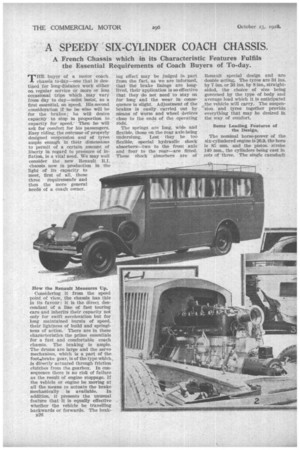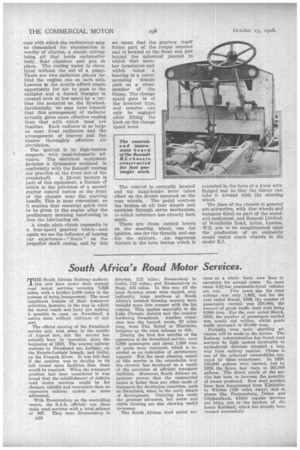A SPEEDY SIX-CYLINDER COACH CHASSIS.
Page 10

Page 11

Page 12

If you've noticed an error in this article please click here to report it so we can fix it.
A French Chassis which in its Characteristic Features Fulfils the Essential Requitements of Coach Buyers of To-day.
1[1141i. buyer of a motor coach chassis to-day—one that is destined for long-distance work either on regular service or -more* or kss occasional trips which may vary from day to day—mast insist, as a first essential, on Speed. His second consideration if -be. be wise will be . for the brakes; he will desire canacitY to stop in proportion to capacity for speed: Then he -will ask for comfort for his passengers. Easy riding, the outcome of properly designed stiSPension and of tyres ample enough in their dimensions to permit of a .certain amount of liberty in regard to pressure of inflation, is a vital need. We may well consider the new Renault R.I. chassis now in production in the light of its capacity to meet, first of all, these three requirements and then the more general needs of a coach owner.
How the Renault Measures Up.
Considering it from the speed point of view, the chassis has this in its favour : it is the direct descendant of a line of fast touring ears and inherits their capacity not only for swift acceleration but for long maintained bursts of speed, their lightness of build and springiness of action. There are in these characteristics the prime essentials for a fast and comfortable coach chassis. The braking is ample. The drums are large and the servo mechanism, which is a part of the footebrake gear, is of the type which is directly actuated through friction clutches from the gearbox. In consequence there is no risk of failure as the result of engine stoppage. If the vehicle or engine be moving at all the means to actuate the brake mechanically is available. In addition, it presents the unusual feature that it is equally effective whether the vehicle be travelling backwards or forwards. The brak
B26 ing effect may be judged in part from the fact, as we are informed, that the brake linings are longlived, their application is so effective that they do not need to stay on for long and the wear in consequence is slight. Adjustment of the brakes is easily carried out by nieans of worm and wheel deviees close to the ends of the operating rods.
The springs are long, wide and flexible, those on the rea.r axle being underslung. Lest they be too flexible, special hydraulic shock absorbers—two to the front axle and four to the rear—are fitted. These shock absorbers are of
Renault special design and are double acting. The tyres are 34 ins. by 7 ins. or 36 ins. by 8 ins., straightsided, the choice of size being governed by the type a body and average load which it is anticipated the vehicle will carry. The suspension and tyres together provide everything that may be desired in. the way of comfort.
Some Leading Features of the Design.
The nominal horse-power of the six-cylindered engine is 26_9, the bore is 85 mm. and the piston stroke 140 mm., the cylinders being cast in sets of three. The single camshaft operates side-by-side valves and the crankshaft is of high resistance nickel steel. An outcome of the manufacturer's touring car experience to which we have already referred as being embodied in the design of this chassis is exemplified in the care which has been taken in the arrangement of the lubricating system of the engine. An oil purifier is fitted and a cooler or radiator for the lubricant. The result is economy in cil consumption yet more effective and satisfactory lubrication of vital engine parts. The engine is beautifully finished and smooth on its exterior, so that there is no difficulty in maintaining it in first-class condition externally. The design of the bonnet, which follows the well-known Renault practice, with the radiator behind and the engine completely accessible when the bonnet is lifted, is a further help towards ease of engine maintenance, whilst the completeness with which the engine is displayed with the bonnet lifted is a spur to even the least engine-proud of drivers. The engine is secured in place by four substantial bolts passing through brackets which are fastened direct to the main side member of the frame. Removal of these four bolts frees the engine once the universal joint between the clutch and gearbox is disconnected, and that is a simple matter.
It is worthy of note here that the designers have been most assiduous in their attention to the need for accessibility. As an example, the
ease with which the carburetter may be dismantled for examination is worthy of citation, a simple stirrup being all that holds carburetter body, float chamber and jets in place. The cooling water is circulated without the aid of a pump. There are two radiators placed behind the engine, one on each side. Louvres in the scuttle afford ample opportunity for air to pass to the radiator and a forced draught is created even at low speed by a turbine fan mounted on the flywheel. Incidentally, we may here remark that this arrangement of radiator actually gives more effective cooling than that with which most are familiar. Each radiator is as large as most front radiators and the arrangement of louvres and fan ensure thoroughly effective air circulation.
. The ignition is by high-tension magneto with semi-automatic advance. The electrical equipment includes a dynamotor mounted in conformity with the Renault touring car practice at the front end of the crankshaft. A 24-volt battery is part of this equipment, a feature ot which is the provision of a second starter control button at the front of the chassis near the starting handle. This is most convenient, as it enables that essential quick turn to be given to the engine after the preliminary morning hand-swing to free the lubricating oil.
A single plate clutch transmits to a four-speed gearbox which—and again we see the influence of touring car experience—" floats" on the propeller shaft casing, and by this
we mean that the gearbox itself forms part of the torque member and is located at the front end just behind the spherical journal in which that member terminates and which takes a bearing in a corresponding female part on a crossmember of the frame. The change speed gate is of the inverted type, and reverse can only be engaged after lifting the knob on the change speed lever.
The control is centrally located and the hand-brake lever takes effect on the drums mounted on the rear wheels. The pedal controls the brakes on all four wheels and operates through servo mechanism, to which reference has already been made.
There are three control levers on the steering wheel, one for ignition, one for the throttle and one for the mixture. An ingenious feature is the horn button which is
extended in the form of a lever with flanged end so that the driver can take it around with the steering wheel.
The lines of the chassis in general are attractive, with disc wheels and bumpers fitted as part of the standard equipment, and Renault Limited, of Westfielcls Road, Acton, London, W.3, are to be complimented upon the production of an eminently sound motor coach chassis in the model R.T.


































